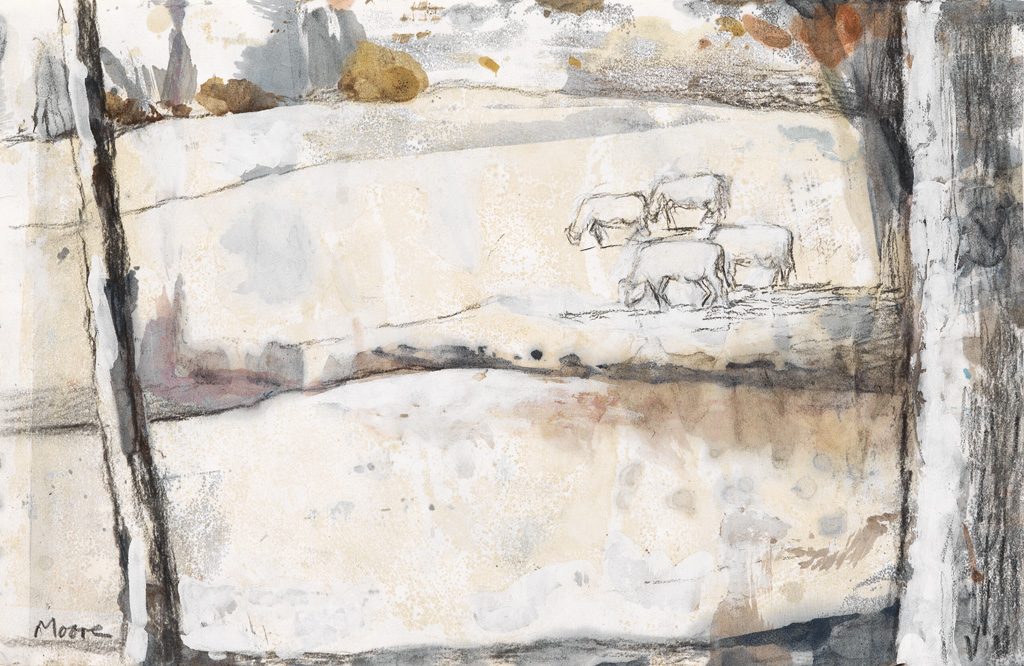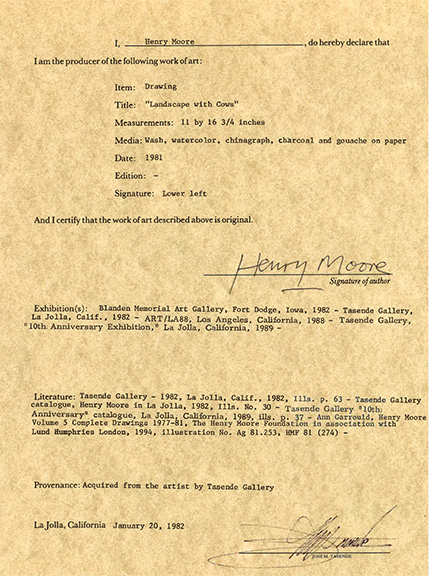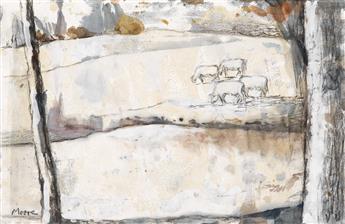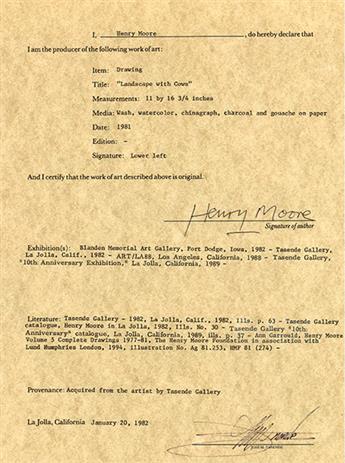Sale 2375 - Lot 619
Unsold
Estimate: $ 15,000 - $ 20,000
HENRY MOORE
Landscape with Cows.
Watercolor, gouache and charcoal on paper, 1981. 280x424 mm; 11x16 5/8 inches. Signed in charcoal, lower left recto. Ex-collection David C. Copley, La Jolla, California; Tasende Gallery, La Jolla, California, 1982; private collection, Germany.
Exhibited "Henry Moore," Blanden Memorial Art Gallery, Iowa, 1982; "Henry Moore," Tasende Gallery, La Jolla, California, 1982, illustrated page 63; "ART/LA88," Los Angeles, California, 1988; "10th Anniversary Exhibition," Tasende Gallery, La Jolla, California 1989, illustrated page 37.
Published in Garrould, Henry Moore: Complete Drawings 1919-1981, 1994, number AG 81.253.
With a certificate of authenticity from the artist dated January 20, 1982.
Moore (1898-1986) was a British sculptor, draughtsman and printmaker whose extensive, 60-year career helped shape and define British Modernism. Born in a coal mining town in Yorkshire, Northern England, Moore was the seventh of 8 children. He was drawn to sculpture from an early age, when at 8 years old his Sunday school class had a lesson about Michelangelo
After serving in France during World War I, Moore studied at the Leeds School of Art and subsequently at the Royal College of Art in London. There he took advantage of the city's museums and libraries and studied a varied range of art history, including African sculpture and early Egyptian and Mexican art. Moore soon absorbed this exposure to Ethnographic art into his work, and many of his instructors were unsupportive of his deviation from their traditional instruction regarding the classical form, deeming it too modern.
Nevertheless, Moore began teaching at the Royal College of Art in 1924, where he was an instructor of sculpture for seven years. This post allowed him to freedom to focus on his own work in addition to teaching. The sculptor Barbara Hepworth (1903-1975) was a close friend who lived near Moore in Hampstead, a small village in London where an artistic community formed around them and other artists in the 1930s.
At the onset of World War II, Moore was teaching at the Chelsea School of Art in London but resigned and moved to Much Hadham with his wife, where he remained for the rest of his life. Moore quickly gained recognition as a leading British artist, and began exhibiting regularly and receiving important commissions both in England and abroad. His abstracted, and sometimes monumental, sculptures exploring the human form can be found in major museums and public spaces around the world.
Landscape with Cows.
Watercolor, gouache and charcoal on paper, 1981. 280x424 mm; 11x16 5/8 inches. Signed in charcoal, lower left recto. Ex-collection David C. Copley, La Jolla, California; Tasende Gallery, La Jolla, California, 1982; private collection, Germany.
Exhibited "Henry Moore," Blanden Memorial Art Gallery, Iowa, 1982; "Henry Moore," Tasende Gallery, La Jolla, California, 1982, illustrated page 63; "ART/LA88," Los Angeles, California, 1988; "10th Anniversary Exhibition," Tasende Gallery, La Jolla, California 1989, illustrated page 37.
Published in Garrould, Henry Moore: Complete Drawings 1919-1981, 1994, number AG 81.253.
With a certificate of authenticity from the artist dated January 20, 1982.
Moore (1898-1986) was a British sculptor, draughtsman and printmaker whose extensive, 60-year career helped shape and define British Modernism. Born in a coal mining town in Yorkshire, Northern England, Moore was the seventh of 8 children. He was drawn to sculpture from an early age, when at 8 years old his Sunday school class had a lesson about Michelangelo
After serving in France during World War I, Moore studied at the Leeds School of Art and subsequently at the Royal College of Art in London. There he took advantage of the city's museums and libraries and studied a varied range of art history, including African sculpture and early Egyptian and Mexican art. Moore soon absorbed this exposure to Ethnographic art into his work, and many of his instructors were unsupportive of his deviation from their traditional instruction regarding the classical form, deeming it too modern.
Nevertheless, Moore began teaching at the Royal College of Art in 1924, where he was an instructor of sculpture for seven years. This post allowed him to freedom to focus on his own work in addition to teaching. The sculptor Barbara Hepworth (1903-1975) was a close friend who lived near Moore in Hampstead, a small village in London where an artistic community formed around them and other artists in the 1930s.
At the onset of World War II, Moore was teaching at the Chelsea School of Art in London but resigned and moved to Much Hadham with his wife, where he remained for the rest of his life. Moore quickly gained recognition as a leading British artist, and began exhibiting regularly and receiving important commissions both in England and abroad. His abstracted, and sometimes monumental, sculptures exploring the human form can be found in major museums and public spaces around the world.
Exhibition Hours
Exhibition Hours
Aliquam vulputate ornare congue. Vestibulum maximus, libero in placerat faucibus, risus nisl molestie massa, ut maximus metus lectus vel lorem.






